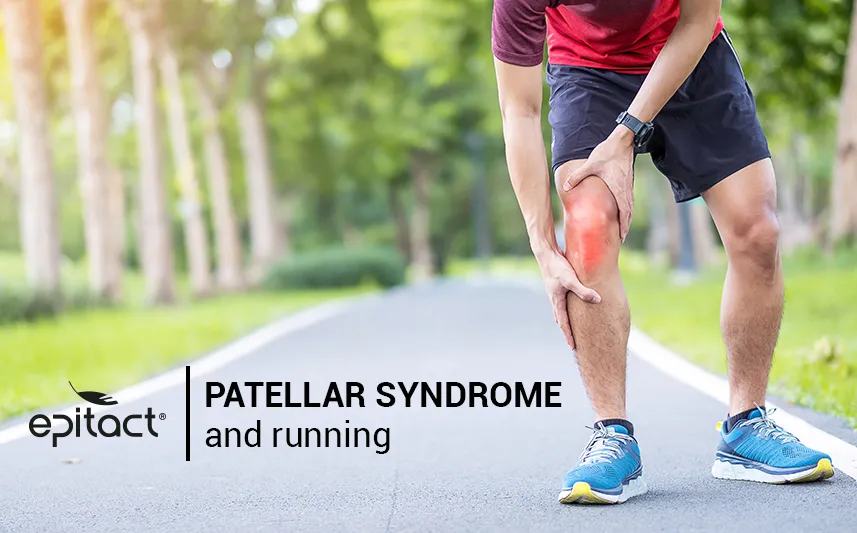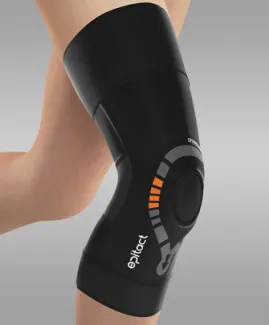
The runner is stubborn (runner’s words!), he likes and wants to run despite the weather, the time, the tiredness, and sometimes even when he is in pain. One of the most common running injuries is patellofemoral pain syndrome, also known as runner’s knee. Sometimes, the level of pain is so high that people look for efficient solutions to relieve it and keep running.
Why is the link between patellofemoral pain syndrome and running? Can you run with a runner’s knee? EPITACT® answers and introduce you its innovative patellofemoral pain syndrome brace for running*.
Related articles:
- Understanding the runner's knee in sportsperson
- Treating and preventing patellofemoral pain syndrome
Can I keep running with patellofemoral pain syndrome or runner’s knee?
Running with a runner’s knee causes intense and disabling pain. It is better not to run with patellofemoral pain syndrome. Indeed, repetitive flexions and extensions of the knee are one of the most frequent factors causing knee pain when running. However, as soon as the pain has been treated, you could run again.
Runner’s knee and running: description of pain
When a runner suffers from patellofemoral pain syndrome, the pain can appear before and/or after long runs. This pain is felt in front of the knee and varies between shooting pain, diffuse pain and acute pain. When the pain is manageable, it can be felt at the start of the running session and disappear quite quickly once the body is warmed up.
Nevertheless, this pain reappears once the training is over as soon as you sit down again. When the pain is acute as soon as you wake up, it’s difficult to go running with a runner’s knee. In this case, the pain is often felt all day long and is really disabling.
How is patellofemoral pain syndrome treated?
Make an appointment with your doctor to confirm the diagnosis: a sports specialist preferably. He will probably prescribe you physiotherapy sessions.
In the meantime, even if the only thing you’re thinking is: 'No way, I have a run to train!', you have to reduce the training load (sorry but it’s for your own sake!). This step is important to reduce the stress on your patellofemoral joints.
In order to reduce the inflammation of your joint and in addition to rest:
- Avoid shuffling (make big steps);
- Limit prolonged sitting as far as possible;
- Practice stretching of the calf, hamstrings and quadriceps;
- For those who really miss physical efforts, you can use an exercise bike on low resistance. It’s recommended and perfect for recovery.
How to prevent the pain from patellofemoral syndrome in running?
- Think about doing warm up exercises before and stretches after running.
- If you’re resuming sports, try to practice on flat grounds rather than on excessive slopes.
- Diversify your running sessions with other sports like swimming or cycling for example.
- Choose quality equipment: the type and state of your shoes are very important to prevent knee injuries.
- Give your knee time to recover between two sports sessions so that it is not overworked.
- Wear a comfortable and light knee brace that efficiently holds your knee. EPITACT® has created the PHYSIOstrap™ Sport*, a patellofemoral pain syndrome brace for running that prevents or eases knee pain caused by runner’s knee.
In conclusion, it is important to take care of your knees, especially when you runs! Running with a runner’s knee is not recommended, you should stop running and rest your knee joints first. Indeed, the repetition of movements during each stride contributes to the wear and tear on the cartilage and it’s more pronounced if you suffer from a patellofemoral syndrome.
Do not hesitate to share your personal experience if you’re running with patellofemoral pain syndrome! Let us know how you’re managing/healing your knee pain.
*This solution is a class I medical device that bears the CE marking under this regulation. Carefully read the instructions before use. Manufacturer: Millet Innovation. 06/2023
 Pharmacie
Pharmacie